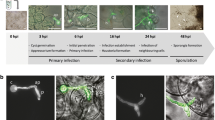Summary
With the aim of better understanding in vitro host-parasite interactions, tomato cell lines selected for altered response to Fusarium oxysporum f. sp. lycopersici cell wall components were further characterized. Particularly, their behaviour in dual culture in regard to both fungal inhibition and peroxidase activation was analysed and selected, and control cell clones were screened for esopolysaccharide content and toxin tolerance. Interclonal differences in growth response to 2,4-D and DMSO and the capacity to grow on a medium devoid of hormones (habituation) were taken as parameters representative of physiological variability not directly correlated with the response to pathogens. Significant differences between clones selected for increased (F+) and decreased (F−) response to fungal elicitors were found for pathogen inhibition, peroxidase and esopolysaccharide content, toxin tolerance being reduced in F but not significantly different from the control in F+. As expected, clonal variability for the response to 2,4-D and DMSO, although significant, was not connected with hostparasite interactions. The data reported thus show that selection for a character (response to elicitors), probably critical for the response to pathogens, may lead to the recovery of genotypes showing a set of modifications suggestive of a cascade of events leading to active defense.
Similar content being viewed by others
References
Aist JR (1983) Structural responses as resistance mechanisms. In: Bailey JA, Deverall BJ (eds) The dynamics of host defense. Academic Press, Australia, pp 33–70
Ampomah YA (1983) Aspects of phenolic metabolism in the potato in response to challenge by Phytophthora infestans (Mont.) de Bary and Phoma exigua Desm. var. foveata. PhD thesis, University of Hull
Bradford M (1976) A rapid and sensitive method for the quantitation of microgram quantities of protein using the principle of protein-dye binding. Anal Biochem 72:248–254
Buiatti M (1989) The molecular basis of somaclonal variation. In: Genetic manipulation in plant breeding. Eucarpia Congress, Helsingor (in press)
Buiatti M, Scala A (1984) In vitro analysis of plant-pathogen interactions and selection procedures. Proc Intl Symp Plant Tiss Cell Cult Applic Crop Improvement. Olomouc (Czechoslovakia), Sept 24–29, pp 331–339
Buiatti M, Simeti C, Marcheschi G, Scala A, Bettini P, Bogani P, Pellegrini MG (1987) Isolation of tomato cell lines with altered response to Fusarium cell wall components. Theor Appl Genet 75:37–40
Buiatti M, Pellegrini MG, Storti E, Bettini P, Bogani P, Broggio M, Nascari G, Montanelli C (1988) In vitro markers of resistance and their use in selection programmes. In: Plant molecular pathology. Working seminar of the EEC — ELWW, Florence, pp 32–33
Davis BJ (1964) Disc electrophoresis. II. Method and application to human serum proteins. Ann NY Acad Sci 121:404–427
Durante M, Cecchini E, Citti L, Geri C, Nuti Ronchi V, Parenti R (1984) Habituation and DNA methylation in Nicotiana plant tissue cultures. Atti A.G.I.: 327–328
Gaul H (1961) Studies on diplontic selection after X-irradiation of barley seeds. In: Effects of ionizing radiation on seeds. Vienna IAEA, pp 117–125
Haskins F (1955) Changes in the activities of several enzymes during germination and seedling development in corn (Zea mays L.) Plant Physiol 30:74–75
Kalia P, Sharma SK (1988) Biochemical genetics of powdery mildew resistance in pea. Theor Appl Genet 76:795–799
Kay LE, Basile DV (1987) Specific peroxidase isoenzymes are correlated with organogenesis. Plant Physiol 84:99–105
Matthysse AG, Holmes KV, Gurlitz RHG (1981) Elaboration of cellulose fibrils by Agrobacterium tumefacies during attachment to carrot cells. J Bacteriol 145:583–595
Mueller WC, Beckman CH (1988) Correlated light and electron microscope studies of callose deposits in vascular parenchyma cells of tomato plants inoculated with Fusarium oxysporum f. sp. lycopersici. Physiolo Mol Plant Pathol 33:201–209
Nacmias B, Ugolini S, Ricci MD, Pellegrini MG, Bogani P, Bettini P, Inzé D, Buiatti M (1987) Tumor formation and morphogenesis on different Nicotiana sp. and hybrids induced by Agrobacterium tumefaciens T-DNA mutants. Dev Genet 8:61–71
Smith JA, Hammerschmidt R (1988) Comparative study of acidic peroxidases associated with induced resistance in cucumber, muskmelon and watermelon. Physiol Mol Plant Pathol 33:255–263
Storti E, Simeti C, Bettini P, Bogani P, Minucci C, Vezzosi MC, Pellegrini MG; Buiatti M (1988) Characterization of tomato cell lines altered in in vitro response to Fusarium oxysporum f. sp. lycopersici. Proc 10th Meeting Eucarpia Tomato Working Group, Pontecagnano (SA), Sept 1987, pp 85–90
Vance CP, Anderson JO, Sherwood RT (1976) Soluble and cell wall peroxidases in reed canary grass in relation to disease resistance and localized lignin formation. Plant Physiol 57:920–922
Author information
Authors and Affiliations
Additional information
Communicated by G. Wenzel
Rights and permissions
About this article
Cite this article
Storti, E., Bogani, P., Bettini, P. et al. The pleiotropic phenotype of tomato cells selected for altered response to Fusarium oxysporium f. sp. lycopersici cell wall components. Theoret. Appl. Genetics 78, 689–695 (1989). https://doi.org/10.1007/BF00262565
Received:
Accepted:
Issue Date:
DOI: https://doi.org/10.1007/BF00262565




